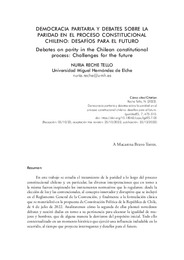Por favor, use este identificador para citar o enlazar este ítem:
https://hdl.handle.net/11000/35138Registro completo de metadatos
| Campo DC | Valor | Lengua/Idioma |
|---|---|---|
| dc.contributor.author | Reche Tello, Nuria | - |
| dc.contributor.other | Departamentos de la UMH::Ciencia Jurídica | es_ES |
| dc.date.accessioned | 2025-01-22T10:28:12Z | - |
| dc.date.available | 2025-01-22T10:28:12Z | - |
| dc.date.created | 2022-09 | - |
| dc.identifier.citation | Igualdades, nº7 (2022) | es_ES |
| dc.identifier.issn | 2695-6403 | - |
| dc.identifier.uri | https://hdl.handle.net/11000/35138 | - |
| dc.description.abstract | This paper studies the treatment of parity throughout the Chilean constitutional process and, in particular, the various interpretations that inspired the normative instruments that regulated it: from the election of the conventional ones, to the innovative and disruptive concept that was included in the General Regulations of the Convention, and finally to the classic formulation that materialized in the proposal for the Political Constitution of the Republic of Chile, of July 4, 2022. We will analyze how the second of them raised new debates, and some doubts about to its relevance to achieving equality between women and men, which in some way diverted it from its initial purpose. All this contextualized in a historical moment that exerted an undoubted influence on what happened, while projecting questions and challenges for the future. | es_ES |
| dc.description.abstract | En este trabajo se estudia el tratamiento de la paridad a lo largo del proceso constitucional chileno y, en particular, las diversas interpretaciones que en torno a la misma fueron inspirando los instrumentos normativos que lo regularon: desde la elección de los y las convencionales, al concepto innovador y disruptivo que se incluyó en el Reglamento General de la Convención, y finalmente a la formulación clásica que se materializó en la propuesta de Constitución Política de la República de Chile, de 4 de julio de 2022. Analizaremos cómo la segunda de ellas planteó novedosos debates y suscitó dudas en torno a su pertinencia para alcanzar la igualdad de mujeres y hombres, que de alguna manera la desviaron del propósito inicial. Todo ello contextualizado en un momento histórico que ejerció una influencia indudable en lo ocurrido, al tiempo que proyecta interrogantes y desafíos para el futuro | es_ES |
| dc.format | application/pdf | es_ES |
| dc.format.extent | 36 | es_ES |
| dc.language.iso | spa | es_ES |
| dc.publisher | Centro de Estudios Políticos y Constitucionales | es_ES |
| dc.rights | info:eu-repo/semantics/openAccess | es_ES |
| dc.rights | Attribution-NonCommercial-NoDerivatives 4.0 Internacional | * |
| dc.rights.uri | http://creativecommons.org/licenses/by-nc-nd/4.0/ | * |
| dc.subject | Constitución | es_ES |
| dc.subject | feminismo | es_ES |
| dc.subject | paridad | es_ES |
| dc.subject | democracia | es_ES |
| dc.subject | mujeres | es_ES |
| dc.subject | diversidades | es_ES |
| dc.subject | disidencias | es_ES |
| dc.subject | sexo | es_ES |
| dc.subject | género | es_ES |
| dc.subject | Chile. | es_ES |
| dc.subject.other | CDU::3 - Ciencias sociales::34 - Derecho | es_ES |
| dc.title | Democracia paritaria y debates sobre la paridad en el proceso constitucional chileno: desafíos para el futuro | es_ES |
| dc.title.alternative | Debates on parity in the Chilean constitutional process: Challenges for the future | es_ES |
| dc.type | info:eu-repo/semantics/article | es_ES |
| dc.relation.publisherversion | https://doi.org/10.18042/cepc/IgdES | es_ES |

Ver/Abrir:
2022. ARTICULO REVISTA. DEMOCRACIA PARITARIA (1) (1).pdf
213,48 kB
Adobe PDF
Compartir:
 La licencia se describe como: Atribución-NonComercial-NoDerivada 4.0 Internacional.
La licencia se describe como: Atribución-NonComercial-NoDerivada 4.0 Internacional.
.png)